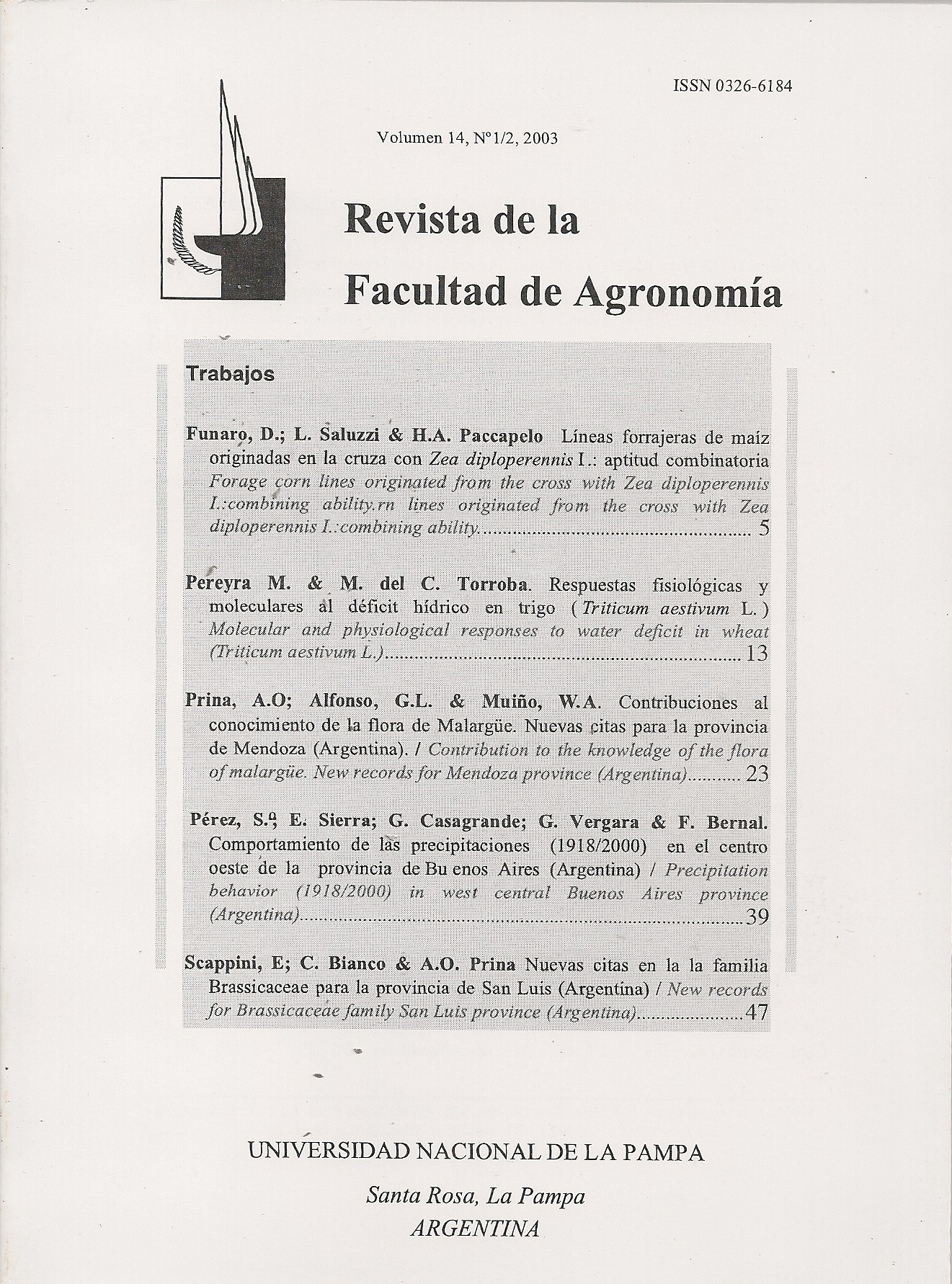Forage corn lines originated from the cross with Zea diploperennis I.: combining ability
Keywords:
corn, Zea diptoperennis I., forage, combining ability, digestible dry matter,Abstract
The forage corns are different from the grain corns in the development of the aereal part, filling grain, maintenance of the vegetative quality of the plant at the harvest moment, percentage of dry matter content and animal uptake. The corn silage was considered as a power food and its nutritious value based on the digestibility and other factors that affect It, and the parameter of the in vitro digestible dry matter of the complete plant and its component (leaf and spike) is used as a selection criterion. The forage value of the inbred lines were not only by its yield, but also through its capacity to produce superior hybrids combinations when crossing each to other. The general combining ability test determine that value. The heterosis of each cross represent the specific combining ability. The purpose of the present research was to study the general and specific combining ability of seven corn forage inbred lines with wild genes Introgression. The following variables were measured: leaf/stem relation, plant height, number of stems by plant, number of spikes by plant, diameter of the main stem and in vitro digestible dry matter. The hybrid 3 (760 x 779) show the greater value of specific combining ability and its component lines the greatest values of general combining ability in plant height, total and spike digestible dry matter production.
Downloads
References
Barrifere, Y., R. Traineau, J.C. Emile & Y. Hitert. 1992. Variation and covaration of silage maize digestibiiity estimated from digestion triais with sheep. Euphytica 59:61-72.
Bruno,, O.A & L.A. Romero. 1994. Efecto del momento de corte sobre la producción de materia seca y calidad de las especies forrajeras. Actualización Técnica sobre Produeci6n de Forrajes Conservados de Aita Calidad. Rafaela,
Burak, R. & L.M. Bertoia. 2001. Aptitud combinatoria en líneas endocriadas de maíz para caracteres forrajeros. VlI Congreso Nacional de Maíz. Pergamino, Buenos Aires. Actas en CD.
Cress, C.E. 1966. Heterosis of the hybrid related to gene freeueney differences between populations. Genetics 53: 269-274.
Cruz, CD. 1997. Programa GENES, Aplicativo computacional em genetica e estadisstica. Editora Universidad Federal de Vicosa (Brasil). 442 p.
Dhilion, B.S., C. Paul, E. Zimmer, P.A. Gurrath, D. Klein & W.G. Pollmer. 1990. Variation and covariation in stover digestibility traits in diaiiei crosses of maize. Crop. Sci. 30:931-936.
Dhilion, B.S., P.A. Gurrath, E. Zimmer, M. Wemike, W.G. Pollmer& D. Klein. 1990b. Analysis of diallei erosses of maize for variation and covariation in agronomic traits at siiage and grain harvest. Maydiea 35: 297-302.
Griffing, B. 1956. Concept of general and specific combining ability in relation to diallei crossing systems. Aust. J. Bid. Sci. 9:463-493.
Jenkis, M.T. 1935. The effeets of inbreeding and selection within Inbred lines of maize upon the hybrids made after successive generations of selfing. Iowa State Col. Jour. Sci. 9:429-450.
Johnson, I.J. & Hayes H.K, 1940. The value in hybrid combinations of inbred lines of com selected from single crosses by the pedigree method of breeding. J. A. Soc. Agr. 32 : 479-485.
Minson, D.J. & M.N. McLeod. 1972. The in vitro digestibility of large number of tropical pastures samples. Tech. Pap. Div. Trop. Past. 8:1-15. CSIRO, Australia.
Paccapelo, H.A., M.L. Molas & L. Saluzzl. 1999. Aptitud forrajera de lineas S originadas del hibrido Zea mays L. x Zea diploperennis Rev. Fac. Agr UNLPam. 10: 59-64.
Roth, L.S., G.C. Marten, A. Compton & D.D. Stuthman. 1970. Genetic variation of quality traits In maize (Zea- mays L.) forage. Crop. Sci. 10:365-367.
Saluzzi, L., D.O. Funaro & H.A. Paccapelo. 2000. Evaluación preliminar de líneas endocriadas obtenidas de la cruza entre Zea mays x Zea diptoperennis. Rev. Fac. Agr. UNLPam. 11:61-70.
Sprague, G.F. 1946. Early testing of inbred lines of corn. Jour. Amer. Soc. Agron. 38:108-117.
Sprague, G.F. & L.A. Tatum. 1942. Genral vs. especlfic combining ability In single cross of com. J. Am. Soc. Agron. 34: 923-932.
Tilley, J.M.A. & Terry, R.A. 1968. Procedure for In vitro digestion of herbage samples. The Grassland Research Institute, Uriey, Berkshire, U.K.
Downloads
Published
Issue
Section
License
La Editorial de la Universidad Nacional de La Pampa (EdUNLPam) exigirá a los/as autores/as la firma del siguiente documento:
La EdUNLPam lleva a cabo la publicación del artículo: (Título del Artículo) en SEMIÁRIDA Rev.Fac.Agron UNLPam ISSN 2362-4337 (impresa) ISSN 2408-4077 (en línea), del cual el/los abajo firmantes son autores de una o más partes. En el mismo acto, el/los autores entregan exclusivamente a la EdUNLPam todos sus derechos protegidos por las leyes de propiedad intelectual que rigen en la Argentina para reproducir, publicar, editar, fijar, comunicar y transmitir públicamente en cualquier formato o medio impreso o electrónico, inclusive internet, el artículo enviado a publicación e incluirlo en índices o bases de datos nacionales e internacionales. A cambio, la EdUNLPam entrega a los autores la autorización para la publicación o reimpresión con ines académicos y educativos en cualquier libro o medio de divulgación, con la sola obligación de citar el artículo original publicado en la EdUNLPam. Cada autor acuerda en que el material provisto a la EdUNLPam es un trabajo original, que no ha sido impreso o publicado en cualquier otro medio con anterioridad y que no vulnera derechos de terceros. El Primer autor tendrá la posibilidad de leer y corregir el artículo ya editado como “prueba de galera”, pero si el autor no devolviera esas correcciones de la prueba de galera dentro del tiempo especificado, el proceso de producción y publicación podrá proseguir sin la aprobación del autor. El/los autor/es no recibirán compensación monetaria de la EdUNLPam por el uso del material contenido en este artículo y asumen la responsabilidad de las opiniones vertidas en él.






.png)



22.png)



.jpg)




.jpg)
